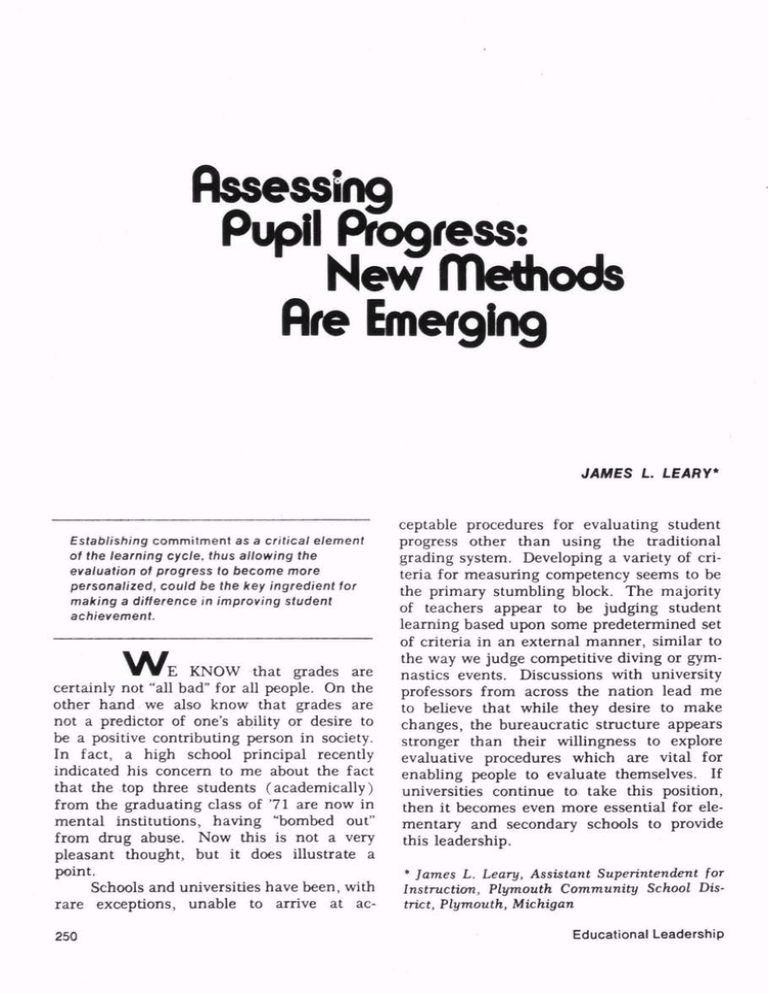
Assessing
Pupil Progress:
New methods
Are Emerging
JAMES L. LEARY*
Establishing c ommitment as a critical element
of the learning cycle, thus allowing the
evaluation of progress to become more
personalized, could be the key ingredient for
making a difference in improving student
achievement.
KNOW that grades are
certainly not "all bad" for all people. On the
other hand we also know that grades are
not a predictor of one's ability or desire to
be a positive contributing person in society.
In fact, a high school principal recently
indicated his concern to me about the fact
that the top three students (academically)
from the graduating class of '71 are now in
mental institutions, having "bombed out"
from drug abuse. Now this is not a very
pleasant thought, but it does illustrate a
point.
Schools and universities have been, with
rare exceptions, unable to arrive at ac250
ceptable procedures for evaluating student
progress other than using the traditional
grading system. Developing a variety of cri
teria for measuring competency seems to be
the primary stumbling block. The majority
of teachers appear to be judging student
learning based upon some predetermined set
of criteria in an external manner, similar to
the way we judge competitive diving or gym
nastics events. Discussions with university
professors from across the nation lead me
to believe that while they desire to make
changes, the bureaucratic structure appears
stronger than their willingness to explore
evaluative procedures which are vital for
enabling people to evaluate themselves. If
universities continue to take this position,
then it becomes even more essential for ele
mentary and secondary schools to provide
this leadership.
* James L. Leary, Assistant Superintendent for
Instruction, Plymouth Community School Dis
trict, Plymouth, Michigan
Educational Leadership
New Evaluation Procedures
Are Emerging
Numerous recommendations for evalu
ating student learning are emerging from
elementary and secondary school faculties,
students, and parents. This is a very healthy
sign that we are entering an era in which
the shackles of letter grades are slowly being
removed. Today there is visible evidence
that schools are not only offering alternate
evaluation procedures, they are supporting
these by sound research. By conducting
thorough investigations and involving diver
sified representation from within the school
community, it is reasonable to assume that
we stand an excellent chance of designing
and implementing improved evaluation pro
cedures.
A current positive trend is the involve
ment of students in the evaluation process.
Parent-teacher conferences are now includ
ing the child. Students are being allowed to
write open-ended answers to test questions
and encouraged to defend their points of
view. True or false and multiple choice
questions are fading rapidly in classrooms
where students are busily preparing to dis
cuss topics which they have chosen. As
teachers acquire greater skills in small group
instruction, they soon recognize that no
teacher can be in multiple classroom dis
cussion groups simultaneously. Therefore,
student involvement in determining what
represents acceptable learning progress be
comes a necessity. We must continue to ex
pand and refine this trend.
The frequency of reporting to parents
is also breaking with past traditions. Rather
than follow a six, nine, or ten week marking
period, educators are recognizing that stu
January 1975
dents and parents vary in their personal
needs to review student growth. Therefore,
flexibility is now being incorporated into
marking schedules. Some teachers are using
a flexible reporting frequency which follows
a weekly or monthly schedule. Other teach
ers are developing efficient tear-off notes
which are given to students each time they
complete a skill or unit assignment.
Evaluation and Commitment
Within the Learning Cycle
It is most encouraging to view the diver
sity being exercised in developing model
evaluation systems. Why this new thrust of
explorations? Perhaps it is because we are
placing evaluation in its proper position
within the learning cycle to assess pro
gress. The function of the learning cycle is
often in conflict with students' hidden mo
tives of enrolling in "snap" courses to get
"good grades," rather than for knowledge
they wish or need to acquire.
Grades have become so prestigious that
we have distorted the evaluation element of
the learning cycle. Sometimes instructors
even use evaluation as a punishment by low
ering a student's grade. We can often find
evidence that evaluation is being used to
control the instructional segment and to de
termine what the teacher considers to be the
most important knowledge for all students
regardless of their needs or interests. (Ex
ample: A recent test question I reviewed
asked: "Name the three most important
dates in Michigan history." How can the
same three dates be the most important for
all people? )
The learning cycle, as presented in
Figure 1 contains five basic elements. The
Figure 1. The Learning Cycle
single element which is most often over
looked is commitment. Yet commitment is
a major factor in motivation; because in
commitment lies personal meaning, under
standing of one's potential, and recognition
of the prescribed treatment. Commitment is
as vital in the academic learning cycle as
it is when a doctor prescribes to patients
that they go on a diet or quit smoking. When
a patient is involved in the process of diag
nosis and prescription and recognizes the
consequences of his or her choices, commit
ment then takes on personal meaning for
seeking a treatment and assessing progress.
In education we tend to omit the ele
ment of commitment from the learning
cycle. Rather, we are more concerned with
making a group diagnosis, prescription,
treatment, and evaluation. Then we wonder
why students feel no personal pride or com
mitment toward "our" subject. Student in
volvement and consequential commitment
take on a variety of features as we consider
different age groups and course offerings.
Nevertheless, each area within the curricu
lum can be tested against all five elements
of the learning cycle.
In schools where grades are being
dropped, we find a "caring for" concept de
veloping that emphasizes personal growth
and recognizes that achievement can often
be measured only in terms of our ability to
live effectively in a pluralistic society. We
see students coming to a realization that a
talent is not recognized until we share that
ability with others. That even competition,
when played by accepted rules is highly
cooperative.
To enhance the "caring for" concept,
252
schools are developing a host of contem
porary course offerings while departing from
the traditional and formal comprehensive
secondary school model. Instruction is now
being presented under such titles as World
Travel Hints, Mini-Course Explorations,
Leisure Time Living, Home and Business
Ecology, Post Graduation Survival, Living in
an Urban Society, and Grass Roots Mechan
ics. Rather than use competitive grades for
these courses, teachers are emphasizing
teacher, student, and group evaluations in a
helping relationship atmosphere. In this
manner all students in the class work to
gether to successfully achieve their goals.
Sustained Leadership Is Critical
A variety of evaluation procedures have
been tried in the past without really taking
a firm hold. In order to "make a difference"
this time, we must be certain that sustained
leadership is built into the change process.
To help cope with this problem, the
Michigan ASCD has established a State Task
Force on Alternatives for Student Evaluation
to serve as a motivating and reinforcing
agent. Now entering its second year, this
task force is studying exemplary evaluation
models, making presentations at local, state,
and national conferences, as well as estab
lishing a clearinghouse for materials and
resource personnel. The committee also
seeks to provide parents, students, and
teachers with information which will help
them deal more effectively with the everyday
problems of student evaluation alternatives
and their implications for the learner. State
wide conferences utilizing the team approach
are currently being planned. The team from
any one district will hopefully consist of
students, teachers, parents, administrators,
and board members.
The time is ripe for educators to put all
elements of the learning cycle into proper
perspective. Establishing commitment as a
critical element for learning, with the con
sequent act of allowing the evaluation of
progress to become more personalized, could
be the key ingredient for making a difference
Q
in improving student achievement.
Educational Leadership
Copyright © 1975 by the Association for Supervision and Curriculum
Development. All rights reserved.

